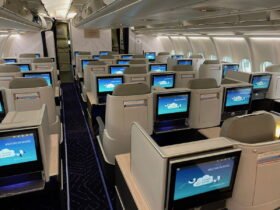Chicago O’Hare Dominates: The 10 U.S. Airports With The Most Non-Stop Destinations
Data from aviation analytics company Cirium shows the ‘most connected airports’ meaning the airports that serve the most destinations. Here are the top 10 U.S. airports, with Chicago O’Hare able to send passengers non-stop to more places than any other.
| Rank | Name | # Destinations | Domestic | International | ||||
| 1 | Chicago O’Hare | 270 | 195 | 75 | ||||
| 2 | Dallas Fort Worth | 261 | 193 | 68 | ||||
| 3 | Atlanta | 237 | 158 | 79 | ||||
| 4 | Denver | 229 | 194 | 35 | ||||
| 5 | Miami | 198 | 88 | 110 | ||||
| 6 | Los Angeles | 195 | 117 | 78 | ||||
| 7 | New York JFK | 193 | 70 | 123 | ||||
| 8 | Houston Bush | 192 | 121 | 71 | ||||
| 9 | Charlotte | 188 | 146 | 42 | ||||
| 10 | Newark | 187 | 95 | 92 |
You might expect the most destinations out of New York, but realize that there are two separate New York airports in the top 10 and also that the number of flights out of New York JFK and New York LaGuardia are both capped (slot restricted). You might also expect Los Angeles to be more connected, but from the West Coast you won’t see service to as many destinations in Europe.
One interesting aspect of mega hubs is precisely this connectivity. Large cities will see service from plenty of airlines, if those carriers can gain access to gates and slots (where required). But Dallas, Atlanta, Denver, and Charlotte clearly punch above their weight.
That’s because of their roles as major hubs for the largest U.S. airlines. It’s precisely that size that supports so much flying. We often think of Charlotte seeing a tradeoff – plenty of non-stop service they wouldn’t otherwise see, but also higher fares from less competition since they’re so dominated by a single carrier. Charlotte of course simply wasn’t built for this.
That’s true but too narrow a view. One of the benefits of airline consolidation, and I’m a frequent critic of it but I can still recognize this, is increase in flying. Despite – indeed, perhaps because of – airline consolidation, there are seven times as many flights in the U.S. compared to deregulation.
While anti-trust analysis usually assumes that merged airlines consolidate and reduce flying, they actually increase flying because of hub effects. A large airline hub supports connectivity. You add a flight to a hub, and that flight can connect passengers to numerous destinations. The larger the airline and hub, the most connections it can support, the more flights it makes sense to add.
In Canada, by the way, Toronto Pearson is the best connected airport – serving 202 destinations, 168 of which are international (the U.S. being, by far, the largest number). Worldwide, Istanbul is top with 309 destinations. Turkish Airlines flies pretty much everywhere.













Leave a Reply